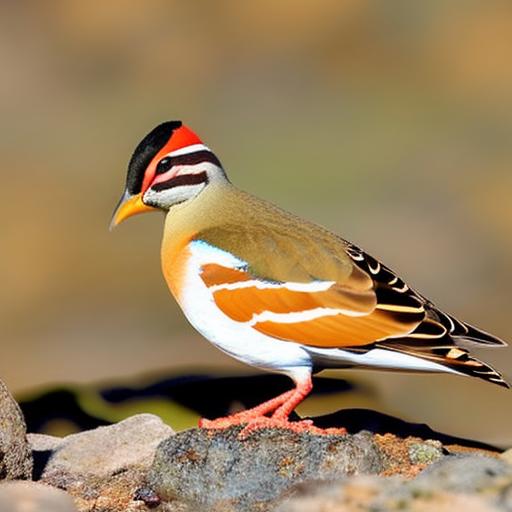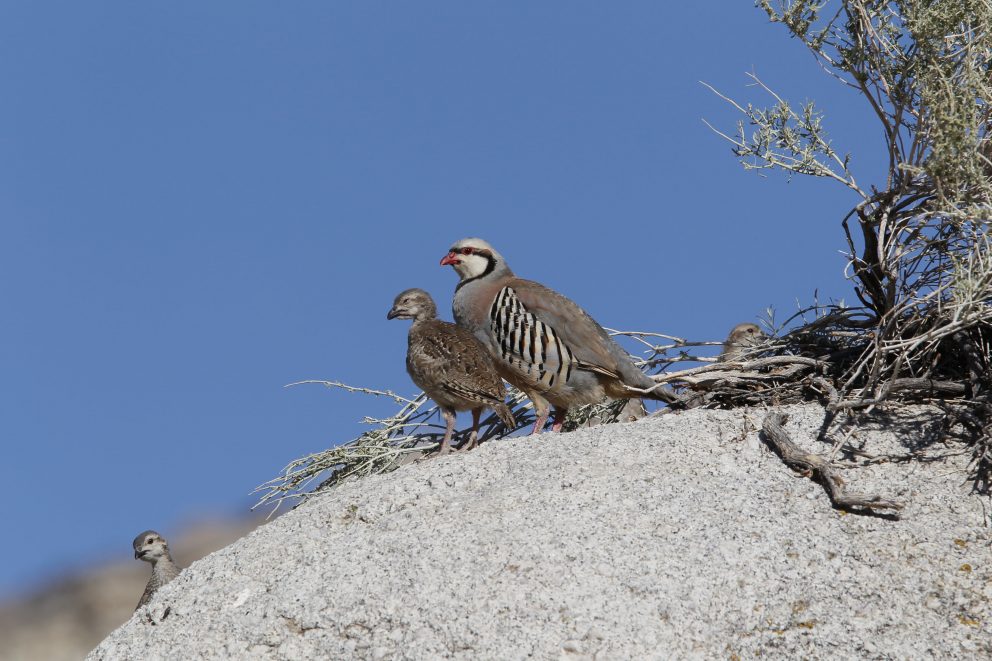Your cart is currently empty!

From Novice to Pro: Understand What Do Chukar Eat to Track Them Down!

Table of Contents
Introduction
Ah, the exhilarating thrill of the hunt! If you’re anything like me, an upland game enthusiast, you know there’s something uniquely rewarding about hunting the elusive chukar. But here’s the catch – no matter how sharp your shooting skills or how stealthy your movements, understanding your prey is half the battle won. You might be wondering, “what do chukar eat?” Well, that’s exactly the golden ticket to get you closer to your quarry. Think about it – when you’re out there in the wilderness, being able to decipher the tell-tale signs of a chukar’s diet could be the difference between going home with a hearty haul or empty-handed. Knowing what do chukar eat not only brings you closer to them but also helps you understand their habits, movements, and favorite haunts. But fear not, whether you’re a newbie eager to learn or a seasoned hunter looking to brush up on your chukar knowledge, we’re about to embark on a fascinating journey together.
The Basics: Who Are the Chukar?
If you’ve ever set foot on the rugged terrains of North America, Central Asia, or Europe, chances are you’ve come across, or at least heard of, the chukar. These resilient little birds, a part of the partridge family, originally hail from the rocky regions of the Middle East and South Asia. Over time, they’ve managed to make themselves at home in a variety of landscapes, from the dry steppes of Asia to the rolling hills of the American West.
The chukar is quite the sight to behold. Sporting a distinctive black band that runs across their eyes and wraps around the back of their head, these birds are unmistakably unique. Their bodies are a blend of gray, brown, and white feathers, with their bright orange-red legs adding a splash of color to their otherwise neutral palette. And if their appearance wasn’t striking enough, wait until you hear their call – a loud, repetitive “chuk-chuk-chuk” that’s sure to echo in your ears if you’ve ever been on a hunt for them.
But their aesthetics and calls aren’t the only things that make them stand out. Chukars thrive in challenging environments. Their preferred habitat? Rocky outcrops, steep terrains, and arid conditions. These birds aren’t ones to settle in lush green forests. They’re the mountaineers of the bird world, scaling high altitudes and navigating rocky terrains with an agility that would make any climber envious.

Now, let’s talk about the real deal – hunting. Among the small game hunting community, the chukar holds a place of reverence. And there’s a good reason for that. Hunting these birds isn’t just about showcasing your shooting skills; it’s a test of endurance, patience, and strategy. The chukar’s preferred rugged terrains mean hunters often have to hike challenging trails, scale steep hills, and sometimes even engage in a bit of rock climbing. But ask any chukar hunting enthusiast, and they’ll tell you – the thrill of the chase, combined with the bird’s elusive nature, makes it all worth it. Plus, let’s not forget the added bonus – understanding what do chukar eat can give you a considerable edge in tracking them down. This isn’t just hunting; it’s a strategic game, a dance between predator and prey, and the chukar sure knows how to lead.
The Chukar Diet: More than Just Seeds!
If you’re thinking chukars are just another seed-pecking bird, brace yourself for a surprise. While it’s true that these birds have a penchant for seeds, their dietary preferences are far more diverse, making the quest to understand “what do chukar eat” an intriguing one.
A Varied Palate: Seeds, Insects, and Beyond
Firstly, let’s dive into the mainstay of their diet – seeds. Chukars are especially fond of grass seeds, which they forage from the ground. But their culinary tastes don’t stop there. They’ve got quite the appetite for a variety of plant materials, including leaves, fruits, and even flowers. Their diet reflects the diversity of their habitat, and as they rummage through the terrains, they adapt and munch on the available vegetation.
Now, for a twist in the plot – chukars are also pretty keen on insects. Whether it’s beetles, ants, or grasshoppers, these birds aren’t ones to pass up a protein-packed snack. For young chicks especially, insects are a crucial part of their diet, offering the essential nutrients needed for rapid growth.
Lastly, in regions where they are available, chukars might also feed on small invertebrates, further diversifying their already varied menu.
Seasons Change, So Does the Menu
Anyone who’s spent time hunting or observing wildlife knows that nature is in a constant state of flux. And as the seasons turn, the chukar’s diet also witnesses a shift. While summer sees them relishing insects and a variety of plant materials, come winter, they lean heavily on seeds as their primary food source. The reason? Insects are scarce in colder months, and seeds offer the necessary sustenance to see them through.
Spring, with its burst of new growth, offers a fresh menu. Chukars indulge in tender shoots, buds, and the occasional early insect. As for autumn, the drop in temperature sees a decline in insect activity, prompting these birds to revert to a seed-based diet, with the occasional fruit thrown in.
Understanding these seasonal dietary shifts is not just an exercise in ornithological curiosity. For hunters, this knowledge is gold. It allows us to predict their movements, identify their favorite feeding grounds, and determine the best times to plan our hunts. After all, knowing what do chukar eat and when they eat it, gives us a sneak peek into their daily routines.
Tracking Techniques: Using Diet to Your Advantage
Ah, the age-old dance between predator and prey! When it comes to chukars, knowing their diet isn’t just a fun fact – it’s the key to tracking them down. As we delve into the world of “what do chukar eat”, let’s see how we can turn this dietary knowledge into our secret weapon in the hunt.
Recognizing Feeding Grounds and Patterns
Every experienced hunter knows that recognizing a game’s feeding grounds is paramount. For chukars, their love for seeds means they’ll frequently be found in grassy patches or fields where these delicious morsels are abundant. Keep an eye out for areas with plenty of ground cover – these sites offer both food and a quick hideaway from predators.
Their insect-craving nature also leads them to areas bustling with insect activity. Damp soil, underbrush, or places with plenty of rocks and crevices are prime locations where chukars might hunt for their protein-rich treats.
Chukar’s Daily Routines and Locations: Dictated by Diet
As the sun rises, chukars typically set out in search of food. Morning and late afternoon are prime feeding times. During scorching midday hours, they prefer to take refuge in the shade, resting and ruminating their food, so plan your tracking activities accordingly.

Their diet also influences their choice of location. In the warmer months, when insects are abundant, chukars might venture into more open areas. Come winter, they’ll gravitate towards terrains that offer seeds, often sticking to one area for longer if the food supply is consistent.
Expert Tips: Turn Diet Knowledge into Tracking Mastery
Seasoned hunters have a few tricks up their sleeves, and I’m about to share some gold with you:
- Listen for the Crunch: Yes, you read that right. If you’re close enough and the surroundings are silent, the sound of chukars munching on seeds or pecking at the ground for insects can be a giveaway.
- Look for Droppings: A sure-shot sign of chukars being around, their droppings can also give you hints about their recent diet. Seeds? Insects? The clues are right there!
- Observation is Key: Spend time observing their behavior from a distance. This not only gives you insights into their feeding habits but also helps you predict their next move.
Remember, chukars are wily creatures. While understanding “what do chukar eat” gives you a leg up, patience, persistence, and keen observation are your best allies. After all, the thrill of the hunt isn’t just in the catch but also in the chase, and knowing your prey inside out makes the chase all the more exhilarating.
Overcoming Challenges: Common Mistakes and How to Avoid Them
Navigating the intricate dance of chukar hunting can be challenging, especially for those just starting out. Often, the biggest mistakes stem from misunderstandings related to “what do chukar eat”. But worry not! With experience comes wisdom, and I’m here to share a bit of both.
Where Novice Hunters Go Wrong: Diet Misconceptions
- One-Dimensional Diet Assumption: One of the most common blunders novice hunters make is pigeonholing chukars as just seed-eaters. While seeds are an essential part of their diet, overlooking their penchant for insects or occasional fruits can send hunters on a wild goose chase, no pun intended.
- Ignoring Seasonal Shifts: Just like us, chukar diets change with the seasons. New hunters often miss out on tracking opportunities because they aren’t aware of these dietary shifts, expecting chukars to frequent the same spots year-round.
- Misreading Signs: Fresh droppings might indicate a chukar was there, but if they’re filled with seeds, and you’re in an insect-rich location, chances are the bird has moved on. Interpreting such signs incorrectly can lead hunters astray.
Anticipating Movements: Eat, Think, Act, Chukar!
For the seasoned hunter, understanding a chukar’s diet goes beyond just knowing “what do chukar eat”. It’s about predicting their next move based on their last meal.
- Mornings are Prime Time: If you’ve identified an area rich in seeds, stake it out early in the morning. Chukars are likely to make their move then, ensuring they have a belly full of energy to kickstart their day.
- Track Water Sources: While this may seem unrelated to diet, remember, chukars need water after a hearty meal, especially if they’ve feasted on dry seeds. Watering holes can be great places to anticipate chukar activity.
- Leverage Insect Abundance: In warmer months, chukars often go where the bugs are. If you come across an area buzzing with insect activity, be patient. It might just be a matter of time before our feathered friends show up for a snack.
- Elevate Your Vantage Point: Chukars prefer high terrains, and often after feeding, they’ll retreat to an elevated spot, digesting their meal while keeping a watchful eye out for predators. Get to higher ground and keep your eyes peeled.
In the world of hunting, knowledge is power, and understanding the intricacies of your prey’s diet can be your ace in the hole. Mistakes are part of the learning curve, but with the right insights and a bit of patience, you’ll find yourself navigating the challenges of chukar hunting like a pro.
Related Questions
How does the chukar’s diet change between seasons?
Ah, the seasonal gourmet choices of the chukar! In the warmer months, these birds relish a mixed bag of goodies, ranging from insects to tender plant shoots and fruits. But as winter knocks, with its chill and scarcity of insects, chukars become more reliant on seeds for sustenance. Spring offers them a fresh palette of young buds and sprouts, while autumn, with its waning insect activity, sees them shift back to a seed-heavy diet with the occasional fruit for good measure.
What are the tell-tale signs in the environment of a chukar’s recent feeding ground?
Keen observation is the key here. Start by looking for chukar droppings; these can give away their recent diet, be it seeds or insects. Keep an eye out for areas with disturbed soil or turned-over leaves, indicating their search for food. Also, patches of grass or plants with missing seeds or nibbled leaves can signal a chukar’s recent feast. It’s all about piecing together these little clues!
How do chukar feeding habits differ from other game birds?
While many game birds have a preferred food source, chukars exhibit a delightful flexibility. Their penchant for both seeds and insects, and the adaptability to switch based on season and availability, sets them apart. Whereas some birds might be strict seed-eaters or insectivores, chukars happily swing between both worlds. This adaptability is a testament to their resilience and ability to thrive across varying terrains and conditions.
Can I use feed to lure and trap chukar?
Well, in theory, you can use feed like seeds to attract chukars, given their love for them. However, chukars are also wily and cautious. Simply setting out a feed and waiting might not yield results. Moreover, depending on your region, there might be regulations against baiting game birds. Always check local hunting laws. Remember, understanding their natural diet and habits offers a more authentic and rewarding hunting experience. Plus, there’s nothing like outsmarting a chukar in its own game!
Summary
And there we have it, folks! From the craggy terrains they frequent to the intricacies of their diet – understanding what do chukar eat is undeniably a game-changer in the hunting realm. Remember, the nuances of their diet can offer invaluable clues about their whereabouts and behaviors. You don’t need to be a seasoned veteran to leverage this knowledge; even if you’re just starting out, this insight can significantly boost your hunting prowess. Every successful hunt, in my experience, is as much about strategy and understanding as it is about skill and precision. So, next time you’re out in the field, equipped with the insights on what do chukar eat, may your hunting endeavors be fruitful and your aim always true. Happy hunting, fellow adventurers!

Herb has been a longtime lover of the outdoors. Whether it be hunting, camping, fishing or just getting outside to reset. Proud father and animal lover. Bourbon anyone?

by
Comments
2 responses to “From Novice to Pro: Understand What Do Chukar Eat to Track Them Down!”
-
[…] come from years of experience and countless hours spent in the woods. So, whether you’re a novice looking to bag your first bird or a seasoned pro seeking to refine your technique, these ruffed grouse hunting tips are tailored just for […]
-
[…] into their behavior and help improve their chances of a successful hunt. Check out the article here to learn more about these fascinating birds and enhance your hunting […]

Categories
- Big Game Hunting (301)
- Deer (202)
- Reviews (3)
- Shooting (16)
- Slingshot (1)
- Small Game Hunting (42)
- Upland Hunting (126)
- Waterfowl Hunting (3)





Leave a Reply